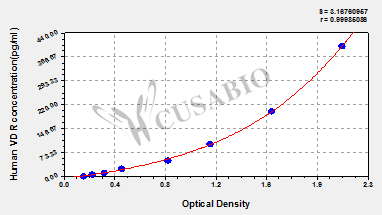The vitamin D receptor (VDR) is a nuclear hormone receptor that mediates the biological effects of 1,25-dihydroxyvitamin D3, the active form of vitamin D. As a ligand-activated transcription factor, VDR regulates calcium homeostasis, bone mineralization, and immune function by controlling the expression of target genes involved in these processes. VDR is expressed in various tissues including intestine, kidney, prostate, and immune cells. This makes it a key mediator of vitamin D signaling pathways and an important research target for understanding metabolic bone diseases, autoimmune disorders, and cancer.
The Human Vitamin D Receptor ELISA Kit (CSB-E05136h) uses a quantitative sandwich assay principle to measure VDR levels in serum, plasma, tissue homogenates, and cell lysates. This kit offers a detection range of 6.25 pg/mL to 400 pg/mL with a sensitivity of 1.56 pg/mL. The assay requires 50-100 μL sample volume and can be completed within 1-5 hours, with detection performed at 450 nm wavelength.
Application Examples
Note: The following application examples are drawn from a selection of publications citing this product. For additional applications, please refer to the full list of references in the "Citations" section.
This ELISA kit has been used in clinical research studies to quantify vitamin D receptor levels in human biological samples as part of biomarker profiling. The kit supports studies examining vitamin D pathway components alongside other metabolic and inflammatory markers in various patient populations.
• Metabolic research: Measuring vitamin D receptor concentrations in studies that evaluate vitamin D status and related biochemical variables including glucose and lipid profiles
• Biomarker correlation studies: Quantifying vitamin D receptor levels alongside inflammatory markers and apoptosis-related proteins to examine potential associations in clinical populations
• Clinical profiling: Measuring vitamin D receptor in serum and plasma samples as part of multi-analyte panels that investigate endocrine and metabolic pathways in patient cohorts






